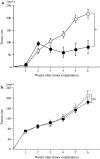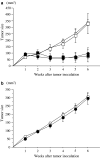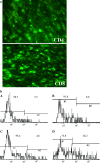Mechanism of antitumor effect on mouse hepatocellular carcinoma by intratumoral injection of OK-432, a streptococcal preparation
- PMID: 17219148
- PMCID: PMC11030927
- DOI: 10.1007/s00262-006-0277-9
Mechanism of antitumor effect on mouse hepatocellular carcinoma by intratumoral injection of OK-432, a streptococcal preparation
Abstract
Intratumoral (i.t.) injection of OK-432, a streptococcal preparation, into implanted tumors of mouse hepatocellular carcinoma (MIH-2) showed antitumor effect including tumor eradication. Intraperitoneal administration of same dose OK-432 did not exhibit tumor suppressive effect. In vitro cytotoxic test suggested that direct cytotoxic effect of OK-432 was not associated with antitumor activity by i.t.-OK-432 treatment. It was also found that Toll-like receptor 4 signaling was not involved in i.t.-OK-432 treatment. Three mice out of five, which had shown tumor eradication by i.t.-OK-432 treatment did not reject re-challenge of MIH-2 cells. Splenocytes from i.t.-OK-432 treated mice did not produce IFN-gamma by stimulation with MIH-2 cells in vitro, but produced abundant IFN-gamma by stimulation with OK-432. Immunofluorescence microscopy demonstrated that CD4+T cells, but not CD8+T cells, infiltrated to i.t.-OK-432 treated tumor tissue produced IFN-gamma. Tumor-infiltrating CD4+T cells from i.t.-OK-432 treated tumor tissue produced IFN-gamma by in vitro stimulation with OK-432 higher than those from untreated tumor tissue. IFN-gamma directly induced apoptosis of MIH-2 cells in vitro. Collectively, i.t.-OK-432 treatment induced priming of CD4+T cells to antigenecity of OK-432, and repetitive i.t.-OK-432 treatment induced IFN-gamma production from OK-432-sensitized CD4+T cells in tumor site, leading to apoptosis of MIH-2 cells susceptible to IFN-gamma.
Figures







Similar articles
-
Interferon-gamma produced by interleukin-12-activated tumor infiltrating CD8+T cells directly induces apoptosis of mouse hepatocellular carcinoma.J Hepatol. 2006 Nov;45(5):662-72. doi: 10.1016/j.jhep.2006.05.018. Epub 2006 Jul 7. J Hepatol. 2006. PMID: 16935390
-
Anti-tumor effect of an intratumoral administration of dendritic cells in combination with TS-1, an oral fluoropyrimidine anti-cancer drug, and OK-432, a streptococcal immunopotentiator: involvement of toll-like receptor 4.J Immunother. 2004 Nov-Dec;27(6):432-41. doi: 10.1097/00002371-200411000-00003. J Immunother. 2004. PMID: 15534487
-
Expression of toll-like receptor 4 on dendritic cells is significant for anticancer effect of dendritic cell-based immunotherapy in combination with an active component of OK-432, a streptococcal preparation.Cancer Res. 2004 Aug 1;64(15):5461-70. doi: 10.1158/0008-5472.CAN-03-4005. Cancer Res. 2004. PMID: 15289356
-
In vivo immunological antitumor effect of OK-432-stimulated dendritic cell transfer after radiofrequency ablation.Cancer Immunol Immunother. 2014 Apr;63(4):347-56. doi: 10.1007/s00262-013-1514-7. Epub 2014 Jan 3. Cancer Immunol Immunother. 2014. PMID: 24384836 Free PMC article.
-
Involvement of Toll-like receptor 4 signaling in interferon-gamma production and antitumor effect by streptococcal agent OK-432.J Natl Cancer Inst. 2003 Feb 19;95(4):316-26. doi: 10.1093/jnci/95.4.316. J Natl Cancer Inst. 2003. PMID: 12591988
Cited by
-
Chronic bacterial osteomyelitis suppression of tumor growth requires innate immune responses.Cancer Immunol Immunother. 2010 Mar;59(3):367-78. doi: 10.1007/s00262-009-0755-y. Epub 2009 Aug 23. Cancer Immunol Immunother. 2010. PMID: 19701748 Free PMC article.
-
Research Progress of Immunotherapy for Gastric Cancer.Technol Cancer Res Treat. 2023 Jan-Dec;22:15330338221150555. doi: 10.1177/15330338221150555. Technol Cancer Res Treat. 2023. PMID: 37042029 Free PMC article. Review.
-
Differential innate immune cell signatures and effects regulated by toll-like receptor 4 during murine lung tumor promotion.Exp Lung Res. 2016 Apr;42(3):154-73. doi: 10.3109/01902148.2016.1164263. Exp Lung Res. 2016. PMID: 27093379 Free PMC article.
-
Pathogen recognition receptors, cancer and inflammation in the gut.Curr Opin Pharmacol. 2009 Dec;9(6):680-7. doi: 10.1016/j.coph.2009.09.006. Epub 2009 Oct 12. Curr Opin Pharmacol. 2009. PMID: 19828376 Free PMC article. Review.
References
-
- Kim SY, Park HC, Yoon C, Yoon HJ, Choi YM, Cho KS. OK-432 and 5-fluorouracil, doxorubicin, and mitomycin C (FAM-P) versus FAM chemotherapy in patients with curatively resected gastric carcinoma: a randomized phase III trial. Cancer. 1998;83:2054–2059. doi: 10.1002/(SICI)1097-0142(19981115)83:10<2054::AID-CNCR2>3.0.CO;2-1. - DOI - PubMed
-
- Ikehara M, Oshita F, Suzuki R, Saitoh H, Yamada K, Noda K. Phase II study of OK-432 intrapleural administration followed by systemic cisplatin and gemcitabine for non-small cell lung cancer with pleuritis carcinomatosa. J Exp Ther Oncol. 2004;4:79–83. - PubMed
-
- Oshimi K, Kano S, Takaku F, Okumura K. Augmentation of mouse natural killer cell activity by a streptococcal preparation, OK-432. J Natl Cancer Inst. 1980;65:1265–1269. - PubMed
Publication types
MeSH terms
Substances
LinkOut - more resources
Full Text Sources
Research Materials

